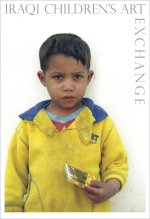Using Art in the International Movement for Children's Rights
Every day, all around the world — in the global south and in the north, in the east and in the west — parents, teachers, therapists, social and humanitarian aid workers give children art materials, with no particular instructions. We encourage children to paint and draw, cut, paste and sculpt for the sheer pleasure of it. But beyond that, we recognize art as an important, powerful and expressive language of childhood — one that gives children another way of recording, organizing and understanding the oftentimes baffling world around them.
"The artist's job is to be a witness to his time in history," said Robert Rauschenberg. The child-as-artist takes this mandate seriously — perhaps more seriously than the adult — using crayons, pencils and paint to give us their witness, their unedited point of view and testimony to their particular historical moment.
Children's basic human rights are guaranteed to them by the Convention on the Rights of the Child. The 1989 document was ratified and endorsed more quickly and by more countries than any previous human rights agreement. Only two countries have not signed on: the United States, and Somalia.
Among other things, the CRC guarantees, in Article 12, children's right to express their views freely in all matters, with their views being given "...due weight in accordance with the age and maturity of the child." And so, we — the collective, worldwide we — have an obligation to pay close attention to children, to make time to watch them, to listen carefully to what they tell us with their games, their interactions with others ... and with their art.
As someone who works with images, children's art and photographs documenting art exchange projects between Iraqi children and children in the Pioneer Valley of Massachusetts where I live, I am struck by the language in Article 12 of the Convention on the Rights of the Child (CRC). I am referring specifically to the term "view" : States Parties shall assure to the child who is capable of forming his or her own views the right to express those views freely in all matters affecting the child, the views of the child being given due weight in accordance with the age and maturity of the child.
Everyone agrees that it is important to include children and youth in discussions, strategy development and decision making about issues large and small, those that involve them directly, and those that affect the broader world around them. We want to know how they feel, and hear their views. We want them to be active participants. But, how can we do that realistically? Beyond the logistics of including them in meetings and discussions, children and youth often find it difficult to communicate with adults. We know, however, that they are always showing us what is on their minds, their ideas and opinions using what some educators have come to call the "hundred languages".
Art is an important language of childhood. It can transcend language and culture, giving children an opportunity to talk to one another and to the wider world. The ICAE works both in the USA and in the Middle East to develop and sustain projects that connect children and use art to meet the educational, social and emotional needs of chhildren and youth.
Links
This Project's Entry for the 2006 Day of Discussion in Geneva
CRIN (Child Rights International Network)
Convention on the Rights of the Child
Child Rights Campaign in the United States
International Childrens Art Foundation
Every Child's Right to Be Heard (5 MB PDF) from Child Rights International Network
